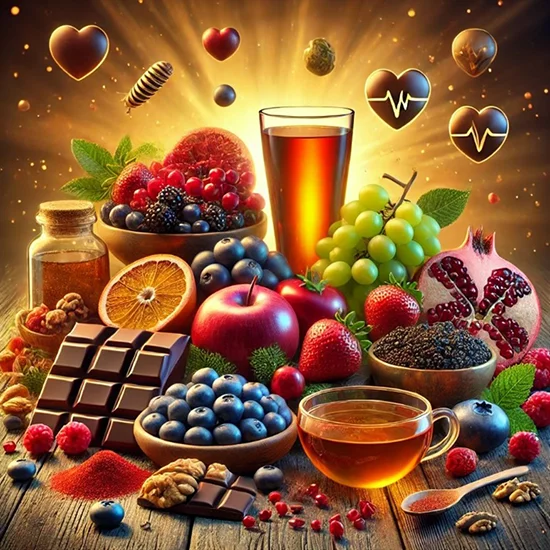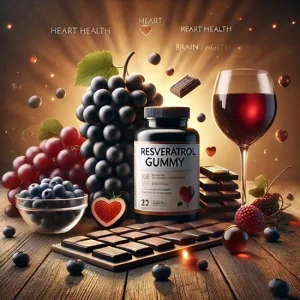The Secret to a Healthy Life is Hidden in Nature!
Some compounds that we unknowingly consume in our daily diet help protect the body against free radicals by strengthening the immune system. One of these powerful compounds is polyphenols. Found in a variety of foods, from fruits and vegetables to coffee and chocolate, polyphenols provide numerous health benefits—from promoting skin regeneration to supporting heart health—thanks to their antioxidant properties.
So, what exactly are polyphenols? How do they work? And what benefits do they offer for our health? Let’s dive into the world of polyphenols!
Polyphenols are divided into different subclasses, including flavonoids, phenolic acids, stilbenes, and lignans. These compounds exhibit various properties beyond their antioxidant capacity, such as anti-inflammatory, cardiovascular protective, and neuroprotective effects. Consuming an adequate daily intake of polyphenols may provide several health benefits, including supporting the immune system, slowing down cellular aging, and regulating metabolic processes.
Phenols are a group of compounds in organic chemistry where a hydroxyl group (-OH) is directly bonded to an aromatic hydrocarbon ring.
These are compounds synthesized as a result of secondary metabolism in plants, consisting of one or more polymerized phenols, phenolic rings with hydroxyl (-OH) groups, or other functional groups, and they help protect plants from external factors.
Secondary metabolites are complex compounds that play important roles in plants. They are not essential for the survival of the plant; however, under stress factors such as ultraviolet light, herbicides, etc., they are produced as a defense mechanism. Additionally, they protect plants from external damage during growth and influence metabolic functions, contributing to plant development.
Polyphenolic flavonoids are many variables in plant compounds. These compounds are exploited in lots of fields. Many herbal compounds are polyphenolic flavonoid compounds. These are used in medicine and health, but they also play an important role in human nutrition. Fruits, vegetables, whole-grain cereals, tea, chocolate, and beverages such as wine are rich sources of polyphenols. Anthocyanins, a subgroup of polyphenols, naturally give fruits and vegetables their color. Additionally, anthocyanins extracted from these fruits and vegetables are used as natural colorants in the food industry.
Olive oil is very important due to its polyphenol content, as it is the only vegetable oil that contains polyphenols. The antioxidant properties of olive oil are directly related to its polyphenol content.
Vegetables, fruits, and beverages contain varying amounts of polyphenols. On average, 100 grams of fresh fruits such as grapes, apples, cherries, and pears contain around 300 mg of polyphenols. Tea, coffee, and red wine typically contain more than 100 mg of polyphenols.
POLYPHENOLS – FOOD SOURCE
Flavonoids
- Catechins: Green tea, black tea, grapes, cocoa, lentils, berries
- Flavanones: Orange, grapefruit, lemon, mandarin, olives, olive oil
- Flavanols: Green vegetables, apple, onion, berries, olive oil
- Anthocyanins: Strawberry, colorful fruits, black grapes, wine, pink olives
Non-Flavonoid Polyphenols
- Resveratrol: Grape skin, red wine, nuts (almond, walnut, etc.)
- Curcumin: Turmeric, mustard
- Coumarin: Strawberry, blueberry, apricot, cherry, cinnamon, licorice
Phenolic Acids
- Ellagic acid: Walnut, strawberry, blueberry, pomegranate, grapes
- Tannic acid: Nettle, tea, berries, olive, olive oil
- Gallic acid: Tea, mango, strawberry, soy, olive, olive oil
- Caffeic acid: Blueberry, kiwi, plum, cherry, apple
Although polyphenols are characterized as chemically having a phenolic structure, this group of natural compounds is highly diverse and includes several subgroups of phenolic compounds.
POLYPHENOL TYPES
You may not have heard of some of them, but they are starting to gain popularity nowadays.
1- Phenolic Acids and Alcohols: Gallic acid, p-hydroxybenzoic acid, Vanillic acid, Ferulic acid, Caffeic acid, Tyrosol, Hydroxytyrosol, Homovanillyl alcohol
2- Flavonoids
2.1- Flavones: Luteolin, Apigenin, Tangeretin
2.2- Flavonols: Quercetin, Kaempferol, Myricetin, Isorhamnetin, Pachypodol
2.3- Flavanones: Hesperetin, Naringenin, Eriodictyol
2.4- Flavan-3-ol Compounds: Catechins and Epicatechins
2.5- Isoflavones: Genistein, Daidzein, Glycitein
2.6- Anthocyanidin Compounds: Cyanidin, Delphinidin, Malvidin, Pelargonidin, Peonidin, Petunidin
3- Lignan Compounds: Secoisolariciresinol, Matairesinol, Sesamin, Pinoresinol
4- Stilbenes: Resveratrol, Pterostilbene
5- Tannins: Tannic acid, Epigallocatechin gallate (EGCG), (−)-Epicatechin gallate (ECG)
6- Coumarins: Coumarin, Warfarin
Features Of Polyphenols
-
Antioxidant Effects
Free radicals, which are highly reactive and short-lived molecules or atoms, are byproducts of metabolism. They damage cell structures and functions in tissues such as nerves, muscles, and bones, leading to cellular dysfunction and tissue damage. Free radicals can contribute to various diseases. Antioxidants neutralize free radicals through electron transfer, helping to reduce the risk of chronic and degenerative diseases such as cancer, cardiovascular diseases, and neurological disorders.
Polyphenols (Ferulic acid, p-Coumaric acid, Caffeic acid, Quercetin, Kaempferol, Luteolin, Naringenin, Delphinidin, Malvidin, Cyanidin) have a higher antioxidant capacity than vitamins. Fruits and vegetables contain antioxidant enzymes such as catalase and glutathione peroxidase. Foods rich in these polyphenols include blueberries, raspberries, blackberries, tomatoes, broccoli, black grapes, garlic, spinach, carrots, and pomegranates.
-
Anti-inflammatory Effects
The immune system synthesizes white blood cells and proteins to protect the body against foreign substances and incorrect signals. Inflammation, which occurs due to persistent and incorrect signals, can damage nerve cells and tissues, cause pain, and accelerate the aging process. Foods rich in omega-3 and polyphenols, such as flaxseed, tea, walnuts, and soy, have anti-inflammatory effects.
-
Polyphenols That Prevent Cardiovascular Diseases
Polyphenols, which have immunomodulatory and vasodilatory effects, reduce the risk of cardiovascular diseases. Epidemiological studies conducted in many countries show that consuming more than 500g of fruits and vegetables daily reduces the risk of cardiovascular disease and stroke. Grape (resveratrol), cocoa, and soy polyphenols are more effective in preventing the risk of cardiovascular diseases and stroke.
-
Polyphenols That Prevent Cancer
Three strategies are suggested for cancer prevention nowadays. The first strategy for prevention involves taking precautions to prevent tumor formation by avoiding harmful chemicals and mutagenic factors in tissues. The second strategy involves inhibiting the progression of cancer through anti-cancer strategies. This includes controlling intercellular signaling, preventing angiogenesis, and strengthening the immune system to slow down cancer progression. The third strategy focuses on preventing metastasis through genetic measures, controlling intercellular contact, and using metabolic methods. Polyphenols are suggested to be effective and beneficial at each of these three stages. Compounds such as resveratrol, quercetin, and epigallocatechin gallate (EGCG) are among the important polyphenols studied in this regard.
-
Polyphenols That Prevent Cardiometabolic Disease
This title mentions the risk of diabetes, heart disease, stroke, and the diseases listed below. Polyphenols help reduce the risk of obesity, insulin resistance, high cholesterol levels, HDL and LDL imbalances, high blood pressure, and metabolic syndrome. Epidemiological studies show that consuming whole grains and legumes is effective in preventing cardiometabolic diseases.
Additionally, they may help keep blood glucose levels under control. According to scientific studies, polyphenols may block the digestion of starch into glucose. Thus, they help prevent a sudden increase in blood sugar levels after meals. Another study suggests that polyphenols support insulin synthesis, which is a stabilizing hormone that helps regulate blood glucose levels. Polyphenol compounds, especially anthocyanins, may help control blood sugar levels.
-
Polyphenols That Help Weight Loss
According to human and animal studies, polyphenols may support the weight loss process by reducing inflammation and boosting metabolic activity.
-
Polyphenols That Regulate Intestinal Flora
There are two types of bacteria in the intestines: beneficial and harmful bacteria. These bacteria form the intestinal flora, also known as the intestinal microbiota. An imbalance between beneficial and harmful bacteria can disrupt the intestinal flora, leading to digestive disorders.
Prebiotic compounds help regulate the digestive system and support the growth of probiotic microorganisms, which strengthen the immune system. According to scientific studies, polyphenols may act as prebiotics, helping to maintain a healthy intestinal flora.
-
Polyphenols That Support Brain Functions
Several studies suggest that polyphenols may help enhance brain function and improve memory.
Summary
Dietary phenolics, or polyphenols, constitute one of the largest and most widely distributed natural compound groups in the plant kingdom. Currently, more than 8,000 phenolic structures have been identified, with over 4,000 classified as flavonoids.
Consuming an adequate amount of polyphenols plays a crucial role in protecting against various diseases and boosting antioxidant levels. Polyphenols not only support the immune system but also help slow down aging effects by improving skin health. Therefore, incorporating polyphenol-rich fruits and vegetables into the diet and supplementing with polyphenols when necessary can be an effective strategy for a healthier life.
References:
- Michel, A. Dobrowolska , A. Kicel , A. Owczarek , A. Bazylko , S. Granica , J. P. Piwowarski and M. A. Olszewska(2014) Polyphenolic Profile, Antioxidant and Anti-Inflammatory Activity of Eastern Teaberry (Gaultheria procumbens L.) Leaf Extracts. Molecules, 19, 20498-20520; doi:10.3390/molecules191220498 .
- http://phenol-explorer.eu/compounds/classification.
- Tsao R. Chemistry and biochemistry of dietary polyphenols. Nutrients. 2010 Dec;2(12):1231-46. doi: 10.3390/nu2121231. Epub 2010 Dec 10. PMID: 22254006; PMCID: PMC3257627.
- Sarişik, Derya & Şahin, F.Neşe. (2021). Polifenollerin Sağlık Ve Spor Performansına Etkileri. Ankara Üniversitesi Beden Eğitimi Ve Spor Yüksekokulu Spormetre Beden Eğitimi Ve Spor Bilimleri Dergisi. 14-29. 10.33689/Spormetre.901644.
- Yildiz Fatih(2010) Advances in Food Biochemistry., CRC Press,Taylor & Francis Group, London, Sayfa 239-289,sayfa 313-339.




